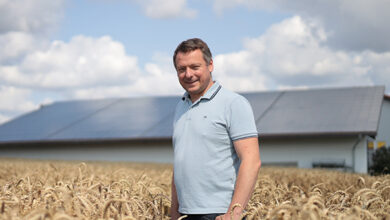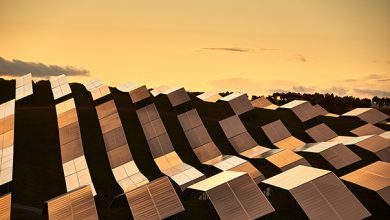All seems right with the world when you immerse yourself in the idyll of Himmighausen. However, the small village in southern East Westphalia is not only a gem in terms of landscape, but also in terms of technology. And behind it all are a landowner and a family business.
Nobility obliges. Anyone like Georg von Puttkamer who is born into a family whose family tree stretches back centuries is used to thinking in long-term dimensions. Of course, not everyone rises to this challenge. But the scion of the noble family, originally from Hinterpommern, follows in the footsteps of his ancestors and endeavors to keep the house, farm and estates together in order to pass them on to future generations.
Corn must make way for park

And since von Puttkamer was not born yesterday and the yields from forestry and fields are not without risk due to climate change and the bark beetle, the qualified forester and tax consultant decided in January 2020 to turn a low-yielding field into a large solar park. And a showcase park at that. After all, the solar park is within walking distance of the family home. And that is, after all, the 300-year-old Himmighausen Castle with its adjoining estate and large landscaped park.
Less representative is the railroad line, which carries passengers and goods from Hanover to the Ruhr region. The busy line runs just a few meters away from the castle and divides the stately garden into two halves, just like the entire estate.
From disadvantage to advantage
However, this railroad line proved to be a suitable building block for the solar park idea. While von Puttkamer’s awareness was focused on the issue of climate change and the need to act responsibly, he realized that the railroad line, which was perceived as a burden, should finally – some 130 years after it was built – serve a good purpose for the company: Land along railroad lines can be used for privileged construction projects such as solar parks. This means that complex development plans and therefore considerable bureaucratic red tape are no longer required for approval. So should four generations of railroad noise be good for something positive after all?
The energy yield of the solar park area is 25 times higher than that of the maize previously growing there, which was intended for biogas plants
Especially as the 16.4 hectares of agricultural land on which the solar park was to be built was rich, but it didn’t make them rich. The field was rich in stones. A country road runs along the other side of the long valley on which the site is located. Railroad line, monoculture, road – a solar park should be most welcome here.
However, the lord of the manor had not reckoned with officialdom, environmental impact assessments and concerned citizens. There were many objections and objections, and the park became a political issue. It took a good two years before the idea slowly became a project. No project without a project developer – this part was taken on by BLG Solar Project from Wolfhagen. And Phoenix Contact became the technical cooperation partner. Not entirely altruistic, as the solar park is located not far from the company’s own All Electric Society Park and serves as an opportunity for visitors to take a look at the practical implementation and expertise of the industry leader from Blomberg.
Diversity instead of monoculture
The result is a very special solar park. It is not only the performance data that is impressive. But also the integration into the landscape. Instead of continuing to eke out a rather dull existence as a monoculture sprayed with artificial fertilizers and pesticides, hedges and native fruit trees will in future divide the 164,000 square metre energy area into small plots.
The idea was not only to combine a habitat for endangered animal and plant species with energy generation, but also to restore the original, small-scale cultural landscape with hedges and grove islands. Sowing native flowers and herbs between the rows of modules provides insects with a rich menu and prevents soil erosion at the same time. Not only insects, but also birds and wild animals find this so interesting that they simply ignore the elevated energy modules or use them as cover. Sheep are used as living lawnmowers to prevent the bushes from taking over the solar panels. The fence that surrounds the entire energy system for security reasons is thus given a second, animal-hunting aspect.
What sounds like an idyll for eco-activists also delights investors. The energy and therefore revenue yield of the former farmland is 25 times higher than before. Not without pride, von Puttkamer calculates that the entire park will be CO2-neutral after around two and a half years, including all emissions during the construction phase and the manufacture of the technologies used.
Stress for the grid

of the project developer BLG Solar Project,
while the park was still under construction
It’s time for a change of scenery. Together with Georg von Puttkamer, we head from the castle to the solar park. Here we meet Burkhard Dittmann. He knows the system and details inside out, as the expert from the Phoenix Contact sales team was involved in the planning and construction of the system from the very beginning.
Von Puttkamer explains as he opens the gate: “The output of 12 GWh from the 25,650 elevated photovoltaic panels covers the needs of around 5,000 single-family homes. Himmighausen, with its 450 inhabitants, will thus become a net exporter of electricity. Burkhard Dittmann adds: “The only catch is that the energy generated here far exceeds the energy required locally, at least if you look at the solar power generated during the day. At night, however, the ratio is reversed. As there is then no energy available from the sun, the local loads have to be supplied by the public power grid. Without suitable control mechanisms, this quickly brings the grid to the edge of its capacity.”
Solar rules of the game
You can tell that the blue-blooded family entrepreneur has also become an expert when it comes to solar parks: “Since 2019, there has been a binding application rule that states that generation systems such as our solar park can be influenced in terms of active and reactive power feed-in via the grid operator’s remote control technology. With this “remote control”, the grid operator can access the park and stabilize the grid frequency and voltage. In addition, the electricity generated can be sold by direct marketers on the electricity exchange.”







It was not an easy path from the initial idea to a functioning solar park. However, the organizational and technical hurdles have now been overcome. The sun is shining, the inverters are humming and the park is making every effort to repay the investment made with renewable and clean energy. Which not only pleases its owner, but also provides the basis for a life for future generations, far beyond the boundaries of their own farm in tranquil Himmigheim.
So lief die Eröffnung des Solarparks
Gut Himmighausen
BLG Solar Project







